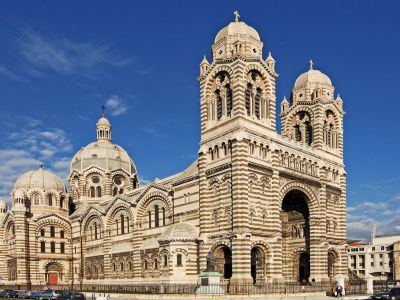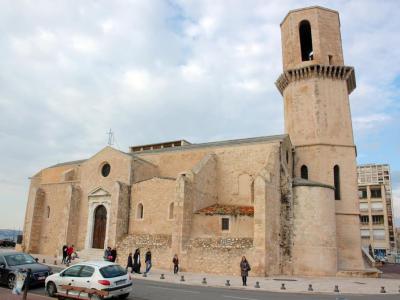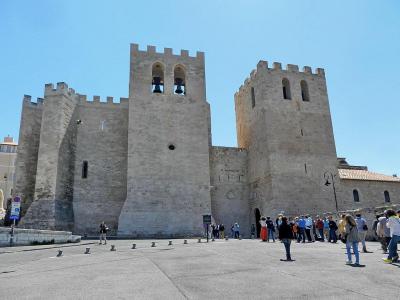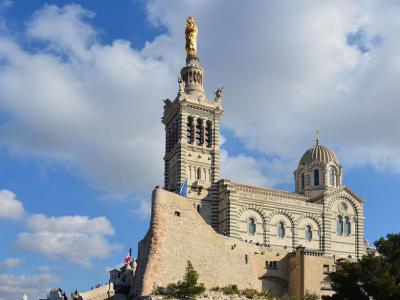Historical Churches Walking Tour (Self Guided), Marseille
Marseille's religious scene, albeit diverse, is dominated by Christianity. The Christian presence in the city dates back to ancient times, making it an integral part of local identity. The vibrant Mediterranean port city also has been a significant pilgrimage destination.
The majority of Christians in Marseille are Roman Catholics, whose prevalence is manifested in the form of multiple historical churches, showcasing various architectural styles, serving as both spiritual and cultural landmarks.
One such is the Marseille Cathedral (Cathédrale de la Major), a magnificent example of 19th-century Neo-Byzantine style. Its striking twin green-and-white striped domes dominate the city's skyline.
Saint-Laurent Church (Eglise Saint-Laurent), in the Panier district, catches the eye with its austere Romanesque exterior. The simple beauty of this temple harkens back to the Middle Ages, providing a serene contrast to the vibrant streets of the neighborhood.
The Church of Saint Ferreol (Église of Saint-Ferréol les Augustins), nestled in the heart of Marseille's old town, is a Gothic masterpiece with an ornate Baroque-style facade – a true testament to the city's architectural prowess.
The Saint-Victor Abbey (Abbaye Saint-Victor) is one of Marseille's oldest religious sites, with roots dating back to the 5th century. This Romanesque abbey, known for its crypt and historic artifacts, holds a special place in the city's history.
Finally, the iconic Byzantine-Revival basilica Notre-Dame de la Garde, perched on a hill overlooking Marseille, for years has been a focal point for both ardent worshipers and tourists seeking breathtaking views of the city and the sea.
As you explore these historical sanctuaries, you can appreciate their architectural beauty but also find some moments of tranquility, through which gain insight into the soul of Marseille. You won't miss this opportunity with the help of our self-guided tour. Visit these locations, explore their stories, and experience the spirituality of this vibrant city firsthand.
The majority of Christians in Marseille are Roman Catholics, whose prevalence is manifested in the form of multiple historical churches, showcasing various architectural styles, serving as both spiritual and cultural landmarks.
One such is the Marseille Cathedral (Cathédrale de la Major), a magnificent example of 19th-century Neo-Byzantine style. Its striking twin green-and-white striped domes dominate the city's skyline.
Saint-Laurent Church (Eglise Saint-Laurent), in the Panier district, catches the eye with its austere Romanesque exterior. The simple beauty of this temple harkens back to the Middle Ages, providing a serene contrast to the vibrant streets of the neighborhood.
The Church of Saint Ferreol (Église of Saint-Ferréol les Augustins), nestled in the heart of Marseille's old town, is a Gothic masterpiece with an ornate Baroque-style facade – a true testament to the city's architectural prowess.
The Saint-Victor Abbey (Abbaye Saint-Victor) is one of Marseille's oldest religious sites, with roots dating back to the 5th century. This Romanesque abbey, known for its crypt and historic artifacts, holds a special place in the city's history.
Finally, the iconic Byzantine-Revival basilica Notre-Dame de la Garde, perched on a hill overlooking Marseille, for years has been a focal point for both ardent worshipers and tourists seeking breathtaking views of the city and the sea.
As you explore these historical sanctuaries, you can appreciate their architectural beauty but also find some moments of tranquility, through which gain insight into the soul of Marseille. You won't miss this opportunity with the help of our self-guided tour. Visit these locations, explore their stories, and experience the spirituality of this vibrant city firsthand.
How it works: Download the app "GPSmyCity: Walks in 1K+ Cities" from Apple App Store or Google Play Store to your mobile phone or tablet. The app turns your mobile device into a personal tour guide and its built-in GPS navigation functions guide you from one tour stop to next. The app works offline, so no data plan is needed when traveling abroad.
Historical Churches Walking Tour Map
Guide Name: Historical Churches Walking Tour
Guide Location: France » Marseille (See other walking tours in Marseille)
Guide Type: Self-guided Walking Tour (Sightseeing)
# of Attractions: 5
Tour Duration: 2 Hour(s)
Travel Distance: 3.6 Km or 2.2 Miles
Author: DanaOffice
Sight(s) Featured in This Guide:
Guide Location: France » Marseille (See other walking tours in Marseille)
Guide Type: Self-guided Walking Tour (Sightseeing)
# of Attractions: 5
Tour Duration: 2 Hour(s)
Travel Distance: 3.6 Km or 2.2 Miles
Author: DanaOffice
Sight(s) Featured in This Guide:
- Cathédrale de la Major (Marseille Cathedral)
- St. Laurent Church
- Église of Saint-Ferréol les Augustins (Church of Saint Ferreol)
- Abbaye Saint-Victor (Saint-Victor Abbey)
- Notre-Dame de la Garde
1) Cathédrale de la Major (Marseille Cathedral) (must see)
The Marseille Cathedral, also known as the Cathedral of Saint Mary Major, unites two eras of faith and architecture. The site includes both the Old Marseille Cathedral, dating to the 12th century, and the New Marseille Cathedral, constructed under Emperor Napoleon III in the late 19th century. Napoleon ordered the older Provençal Romanesque building replaced but preserved part of it—the choir and one bay of the nave—after public protests over its demolition.
The New Marseille Cathedral dominates the waterfront with its vast Romanesque-Byzantine Revival design. Stretching 469 feet in length, with a main dome reaching 231 feet in height, it can hold about 3,000 worshippers. Its façade alternates bands of white and dark stone, a combination of Florentine limestone and Ligurian green porphyry, producing a striped pattern affectionately nicknamed “the Pajamas” by locals. Inside, the cathedral reveals a rich blend of imported materials: white Carrara marble from Italy, onyx from Tunisia, and dazzling Venetian mosaics that illuminate its chapels and domes.
Beside this grand 19th-century structure lie the remains of the Old Cathedral, a humble yet evocative remnant of Marseille’s medieval heritage. The surviving chancel and apse feature smaller side chapels and a cylindrical vault crowned with octagonal and heptagonal domes. Archaeological traces beneath the site even reveal earlier Christian structures dating to the 5th century, showing that this location has been a place of worship for over fifteen centuries.
A visit to Marseille Cathedral offers not just architectural splendor but also some of the best panoramic views of the port and the Mediterranean. Rising between sea and city, the cathedral stands as both a symbol of continuity and a beacon of faith—undeniably one of Marseille’s must-see attractions.
The New Marseille Cathedral dominates the waterfront with its vast Romanesque-Byzantine Revival design. Stretching 469 feet in length, with a main dome reaching 231 feet in height, it can hold about 3,000 worshippers. Its façade alternates bands of white and dark stone, a combination of Florentine limestone and Ligurian green porphyry, producing a striped pattern affectionately nicknamed “the Pajamas” by locals. Inside, the cathedral reveals a rich blend of imported materials: white Carrara marble from Italy, onyx from Tunisia, and dazzling Venetian mosaics that illuminate its chapels and domes.
Beside this grand 19th-century structure lie the remains of the Old Cathedral, a humble yet evocative remnant of Marseille’s medieval heritage. The surviving chancel and apse feature smaller side chapels and a cylindrical vault crowned with octagonal and heptagonal domes. Archaeological traces beneath the site even reveal earlier Christian structures dating to the 5th century, showing that this location has been a place of worship for over fifteen centuries.
A visit to Marseille Cathedral offers not just architectural splendor but also some of the best panoramic views of the port and the Mediterranean. Rising between sea and city, the cathedral stands as both a symbol of continuity and a beacon of faith—undeniably one of Marseille’s must-see attractions.
2) St. Laurent Church
The Saint-Laurent Church is one of Marseille’s finest examples of Provençal Romanesque architecture. Built in the 12th century from warm pink sandstone, it originally served as the parish church for fishermen and sailors who lived and worked along the Old Port. Tradition holds that the church was erected on the remains of an ancient temple of Apollo, a theory supported by the discovery of a sculpted capital now preserved at the Marseille History Museum.
Despite its modest appearance, the Saint-Laurent Church has endured some of the city’s most turbulent eras. It survived the Great Plague of 1720, the French Revolution, and the bombings of World War II, including the devastation caused during the Battle of Marseille in 1943. After the war, it was carefully restored, preserving its original Romanesque nave and rounded arches.
Adjoining the main structure is the Chapel of Saint Catherine, added in the 17th century and easily recognized by its Baroque façade. Inside, the church’s cool stone walls, soft lighting, and votive offerings—often small ship models—recall Marseille’s relationship with the sea.
Today, the Saint-Laurent Church is connected to Fort Saint-Jean by a pedestrian footbridge. It remains an active place of worship and has been a listed Historic Monument since 1950, valued for the quiet strength of its history and faith.
Despite its modest appearance, the Saint-Laurent Church has endured some of the city’s most turbulent eras. It survived the Great Plague of 1720, the French Revolution, and the bombings of World War II, including the devastation caused during the Battle of Marseille in 1943. After the war, it was carefully restored, preserving its original Romanesque nave and rounded arches.
Adjoining the main structure is the Chapel of Saint Catherine, added in the 17th century and easily recognized by its Baroque façade. Inside, the church’s cool stone walls, soft lighting, and votive offerings—often small ship models—recall Marseille’s relationship with the sea.
Today, the Saint-Laurent Church is connected to Fort Saint-Jean by a pedestrian footbridge. It remains an active place of worship and has been a listed Historic Monument since 1950, valued for the quiet strength of its history and faith.
3) Église of Saint-Ferréol les Augustins (Church of Saint Ferreol)
The Church of Saint Ferréol is a Roman Catholic church with a rich and layered history. Originally owned by the Knights Templar, it was granted to a community of Augustinian hermits in 1369. In 1447, they began constructing a new church, which was dedicated in 1542, although the vaulted ceiling was not completed until 1588.
During the Old Regime, the church hosted professional guild ceremonies. The ship-porters’ guild maintained altars dedicated to Saint Peter and Saint Paul as early as 1390. One of the most significant events associated with the site occurred on October 28, 1533, when Pope Clement VII presided over the marriage of noblewoman Catherine de’ Medici and the future Henry II of France, Duke of Orléans. However, the ceremony did not take place inside the Church of Saint Ferréol itself, which was still under construction, but rather in a temporary chapel within the nearby Palace of the Augustinian Priory.
Architecturally, the Church of Saint Ferréol holds many artistic and historical treasures. The high altar, along with the side altars of the Augustinians and ship-porters, was designed by Dominique Fossaty. Inside, visitors can see the Mazenod family tomb from 1564 and the Montolieu family tomb from 1695, as well as the relics of Saint Louis of Toulouse.
The church also contains important works of art. Three paintings by Michel Serre depict Saint Margaret, The Virgin and Child Appearing to Saint Peter, and Saint Paul. Sculptures include a bust of Saint Ferreolus of Vienne and a statue of Saint Augustine by Raymond Servian. A more recent addition, the Holy Family by Yves Le Pape, continues the church’s artistic legacy.
Adding to its grandeur is the neogothic pipe organ, designed by Augustin Zieger in 1844, which remains a centerpiece of this enduring landmark.
During the Old Regime, the church hosted professional guild ceremonies. The ship-porters’ guild maintained altars dedicated to Saint Peter and Saint Paul as early as 1390. One of the most significant events associated with the site occurred on October 28, 1533, when Pope Clement VII presided over the marriage of noblewoman Catherine de’ Medici and the future Henry II of France, Duke of Orléans. However, the ceremony did not take place inside the Church of Saint Ferréol itself, which was still under construction, but rather in a temporary chapel within the nearby Palace of the Augustinian Priory.
Architecturally, the Church of Saint Ferréol holds many artistic and historical treasures. The high altar, along with the side altars of the Augustinians and ship-porters, was designed by Dominique Fossaty. Inside, visitors can see the Mazenod family tomb from 1564 and the Montolieu family tomb from 1695, as well as the relics of Saint Louis of Toulouse.
The church also contains important works of art. Three paintings by Michel Serre depict Saint Margaret, The Virgin and Child Appearing to Saint Peter, and Saint Paul. Sculptures include a bust of Saint Ferreolus of Vienne and a statue of Saint Augustine by Raymond Servian. A more recent addition, the Holy Family by Yves Le Pape, continues the church’s artistic legacy.
Adding to its grandeur is the neogothic pipe organ, designed by Augustin Zieger in 1844, which remains a centerpiece of this enduring landmark.
4) Abbaye Saint-Victor (Saint-Victor Abbey) (must see)
Overlooking the sea stands the Saint-Victor Abbey, a historic monastery that has occupied this site since around 415 CE, being among the first Christian sanctuaries established in Provence. Tradition holds that it was founded by the monk John Cassian, and some believe the crypt contains relics of Saint Victor himself—or even traces of an ancient Greek quarry.
Cassian originally established two monasteries here, one for men and one for women, on opposite sides of the old harbor. Both were destroyed by Saracen raiders in the 8th or 9th centuries, but monastic life resumed in 977. The abbey flourished for several centuries before being stripped of its treasures during the French Revolution in 1794. At various times it served as a warehouse, prison, and barracks, before being restored under Napoleon. In 1934, Pope Pius XI elevated it to the rank of minor basilica following extensive renovation.
Visitors find tombs of saints and bishops, alongside pagan sarcophagi from the early Christian period. Above, the abbey’s crenelated towers offer panoramic views over the harbor and the Mediterranean. Its elevated position near Fort Saint Nicholas once allowed monks to watch for approaching Saracen or Viking ships. Each year on Candlemas, a traditional pilgrimage takes place from the Old Port to the abbey. The Black Madonna, normally kept in the crypt, is wrapped in a green cloak and carried to the square before the church, where she receives a blessing from the bishop.
Tip: It’s worth paying the small entrance fee to visit the crypt—it truly feels like entering another world.
Cassian originally established two monasteries here, one for men and one for women, on opposite sides of the old harbor. Both were destroyed by Saracen raiders in the 8th or 9th centuries, but monastic life resumed in 977. The abbey flourished for several centuries before being stripped of its treasures during the French Revolution in 1794. At various times it served as a warehouse, prison, and barracks, before being restored under Napoleon. In 1934, Pope Pius XI elevated it to the rank of minor basilica following extensive renovation.
Visitors find tombs of saints and bishops, alongside pagan sarcophagi from the early Christian period. Above, the abbey’s crenelated towers offer panoramic views over the harbor and the Mediterranean. Its elevated position near Fort Saint Nicholas once allowed monks to watch for approaching Saracen or Viking ships. Each year on Candlemas, a traditional pilgrimage takes place from the Old Port to the abbey. The Black Madonna, normally kept in the crypt, is wrapped in a green cloak and carried to the square before the church, where she receives a blessing from the bishop.
Tip: It’s worth paying the small entrance fee to visit the crypt—it truly feels like entering another world.
5) Notre-Dame de la Garde (must see)
Notre-Dame de la Garde stands proudly as an opulent Neo-Byzantine church situated atop the highest natural point in Marseille, perched upon a 532 feet limestone outcrop on the south side of the Old Port. This majestic site has become a cherished destination for an annual pilgrimage on Assumption Day.
Conceived by the talented architect Henri-Jacques Espérandieu, the basilica received its consecration on the 5th of June in 1864. Its origins trace back to a church with the same name, first erected in 1214 and later reconstructed during the 15th century. Remarkably, the basilica's foundations rest upon a 16th-century fortress built by Francis I of France to fend off Emperor Charles V's siege of the city in 1536.
The basilica comprises two distinct sections: a lower church or crypt, artistically carved into the rock in the Romanesque style, and an upper church boasting Neo-Byzantine elegance adorned with breathtaking mosaics. Towering above is a square bell-tower, reaching a height of 135 feet, crowned with a belfry standing at 42 feet. At its peak, a monumental statue of the Madonna and Child, crafted from copper gilded with gold leaf, soars to an impressive 27 feet.
During its history, the basilica encountered challenges, particularly regarding the stone used in its construction, which proved susceptible to atmospheric corrosion. In response, extensive restoration work took place from 2001 to 2008. This effort encompassed the meticulous repair of the mosaics, damaged by candle smoke over the years, as well as by bullets during the Liberation of France at the end of World War II.
Conceived by the talented architect Henri-Jacques Espérandieu, the basilica received its consecration on the 5th of June in 1864. Its origins trace back to a church with the same name, first erected in 1214 and later reconstructed during the 15th century. Remarkably, the basilica's foundations rest upon a 16th-century fortress built by Francis I of France to fend off Emperor Charles V's siege of the city in 1536.
The basilica comprises two distinct sections: a lower church or crypt, artistically carved into the rock in the Romanesque style, and an upper church boasting Neo-Byzantine elegance adorned with breathtaking mosaics. Towering above is a square bell-tower, reaching a height of 135 feet, crowned with a belfry standing at 42 feet. At its peak, a monumental statue of the Madonna and Child, crafted from copper gilded with gold leaf, soars to an impressive 27 feet.
During its history, the basilica encountered challenges, particularly regarding the stone used in its construction, which proved susceptible to atmospheric corrosion. In response, extensive restoration work took place from 2001 to 2008. This effort encompassed the meticulous repair of the mosaics, damaged by candle smoke over the years, as well as by bullets during the Liberation of France at the end of World War II.
Walking Tours in Marseille, France
Create Your Own Walk in Marseille
Creating your own self-guided walk in Marseille is easy and fun. Choose the city attractions that you want to see and a walk route map will be created just for you. You can even set your hotel as the start point of the walk.
Food and Shopping Walk
Shopping in Marseille is a great way to mingle with the locals and immerse in new tastes, scents and customs. As with so much else in this melting-pot of a city, the top-of-the-range stores here rub shoulders with the funky little boutiques, high-street chains with scruffy discount outlets or traditional family groceries and bakeries.
Marseille doesn't have a flagship thoroughfare as such,... view more
Tour Duration: 1 Hour(s)
Travel Distance: 1.8 Km or 1.1 Miles
Marseille doesn't have a flagship thoroughfare as such,... view more
Tour Duration: 1 Hour(s)
Travel Distance: 1.8 Km or 1.1 Miles
Marseille Introduction Walking Tour
Alexandre Dumas, the celebrated French novelist, once wrote: “It was in Marseille that I learned the sea can lead anywhere”.
Marseille, set along the sparkling Mediterranean, has been continuously inhabited for over 2,600 years. Its story began around 600 BC, when Greek sailors from Phocaea founded a trading post they called Massalia—a name likely rooted in a local Ligurian term with... view more
Tour Duration: 2 Hour(s)
Travel Distance: 3.8 Km or 2.4 Miles
Marseille, set along the sparkling Mediterranean, has been continuously inhabited for over 2,600 years. Its story began around 600 BC, when Greek sailors from Phocaea founded a trading post they called Massalia—a name likely rooted in a local Ligurian term with... view more
Tour Duration: 2 Hour(s)
Travel Distance: 3.8 Km or 2.4 Miles
Marseille's Old Town
Marseille’s Old Town, known as Le Panier—which means “the Basket” in French—is the historic heart of the city and one of the oldest urban settlements in France. Its name likely derives from an old inn called “The Inn of the Basket,” which existed in the 17th century, though the district itself traces its origins back more than 2,600 years.
Rising above the Old Port, this hillside... view more
Tour Duration: 2 Hour(s)
Travel Distance: 2.9 Km or 1.8 Miles
Rising above the Old Port, this hillside... view more
Tour Duration: 2 Hour(s)
Travel Distance: 2.9 Km or 1.8 Miles
The Most Popular Cities
/ view all











